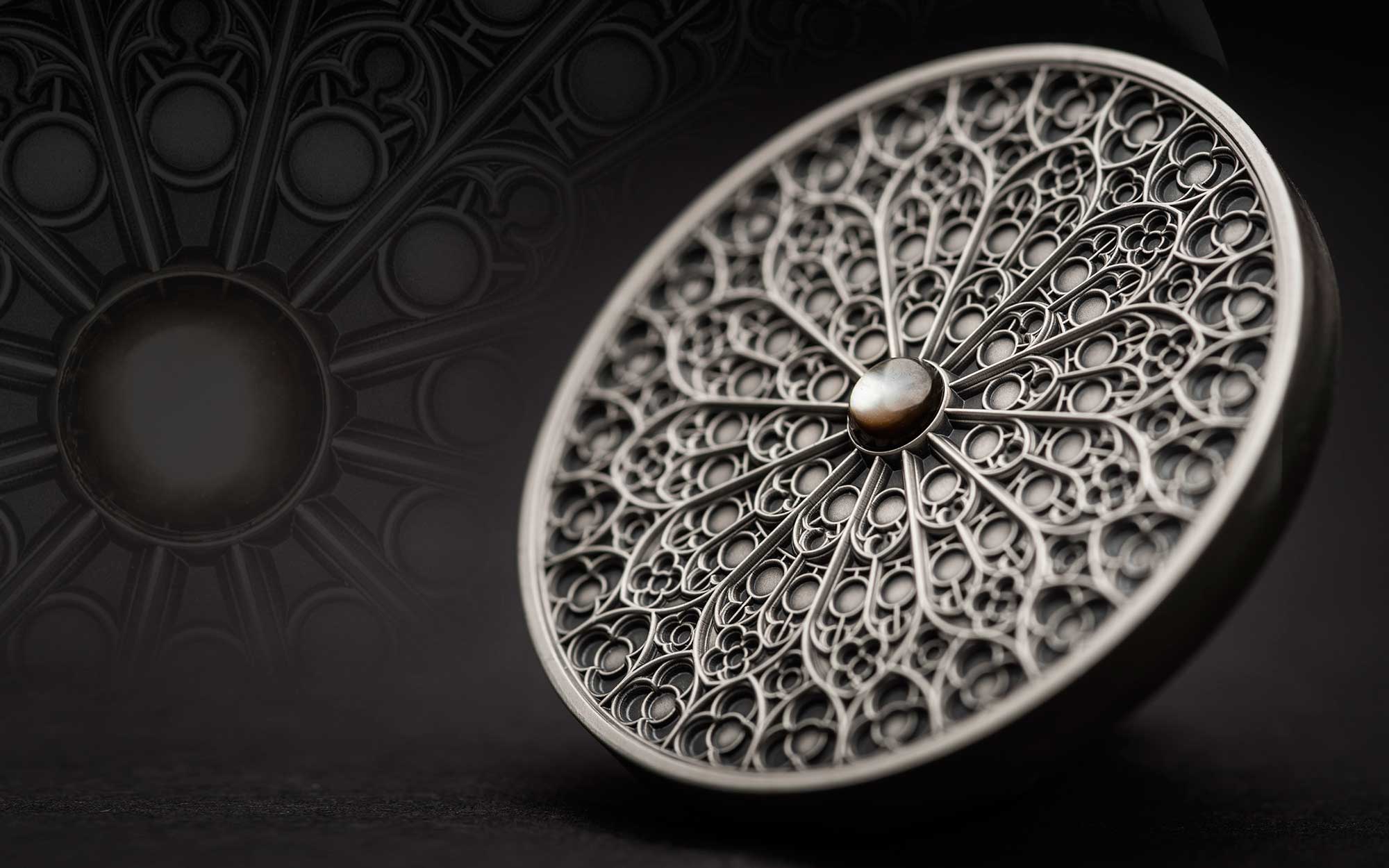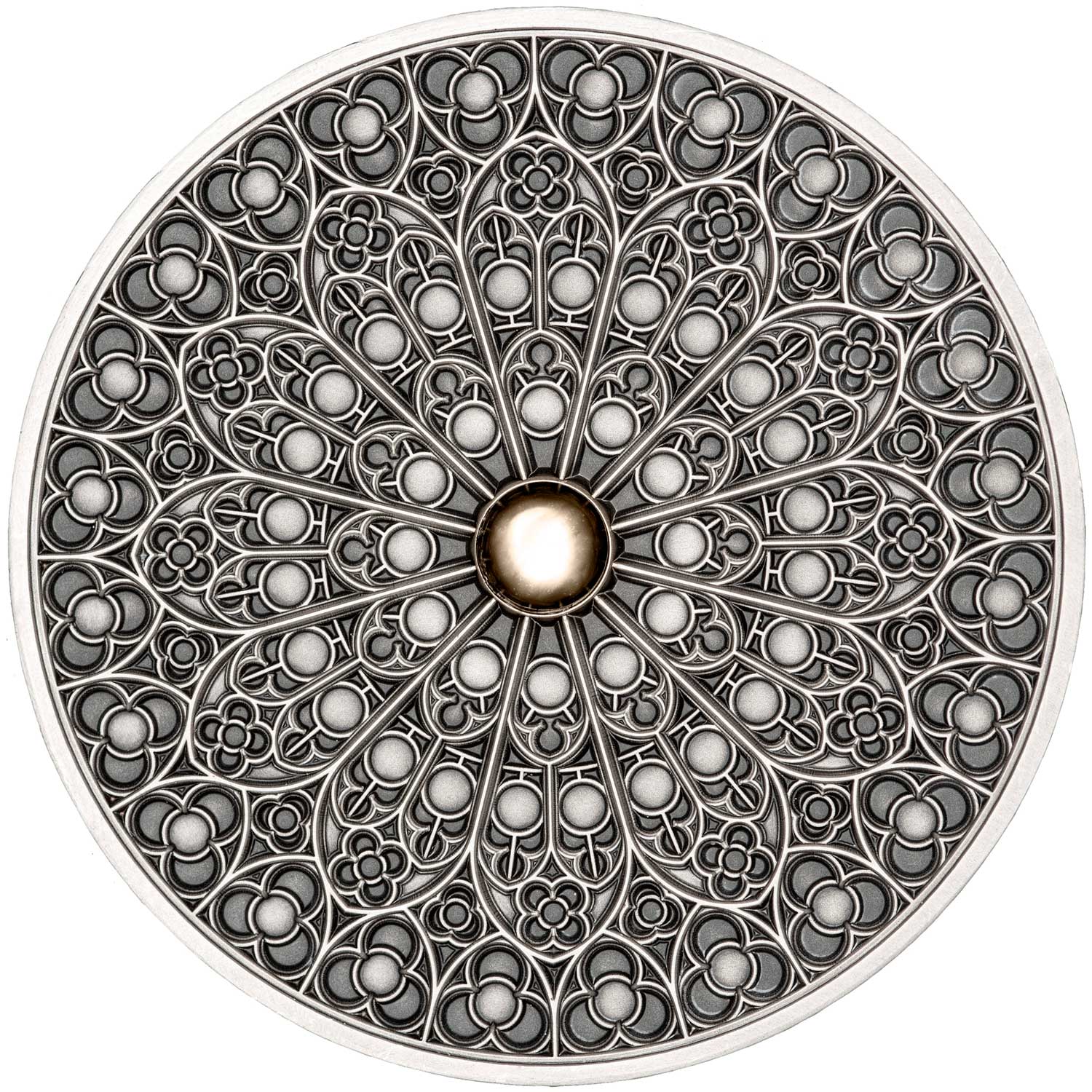Art Mint debuts its fifth Mandala silver coin with Gothic, possibly the series finest release yet
Launched early in 2015, Art Mint’s beautiful new Kalachakra Mandala coin was a big hit, selling out in very quick order. It was something quite new, depicting the concentric, symmetrical patterns of the ancient meditative design with great detail – a very elegant piece of work with its Swarovski crystal embedded at its centre. The following years brought Celtic, Chinese, and Moresque designs, all first class and all subsequent sell-outs. Now the fifth coin is with us and it’s possibly the finest yet.
Gothic architecture started its rise to prominence in early 12th century Europe and amongst its many characteristics were the extensive use of stained glass, and the rose window. The intricacies of some of the medieval windows was quite extraordinary, and Art Mint has taken inspiration with this by combining the style with the mandala design ethos. Early issues in this series had some very good levels of relief, but this one is on a whole other level, with crisp, deep and multi-layered relief surpassing even last years Moresque issue.
No changes to the specification. This is a 3oz fine silver coin, issued for Fiji and carrying the common obverse that has been with the series since its debut. It’s antique-finished and has the serial number engraved on the edge of the coin. An inset crystal or mineral has always been present and Gothic is no exception. A sphere of Nacre – mother-of-pearl – is embedded at the coins centre and does nothing to detract from the finished article. All told, this is a terrific issue and our favourite of the series to date.
Shipping at the end of May, this is limited to the same 500 pieces as previous entrants in the Mandal series have been. It comes boxed with a certificate of authenticity. These are not bargain basement issues of course, so expect to pay around €400 for one. Earlier issues have shown appreciation on the aftermarket, however. Available to order now and a couple of our sponsors have them, so check them out.
WHAT IS A MANDALA?
The meaning of mandala comes from Sanskrit meaning “circle.” It appears in the Rig Veda as the name of the sections of the work, but is also used in many other civilizations, religions and philosophies. Even though it may be dominated by squares or triangles, a mandala has a concentric structure. Mandalas offer balancing visual elements, symbolizing unity and harmony. The meanings of individual mandalas is usually different and unique to each mandala.
The mandala pattern is used in many traditions. In the Americas, Indians have created medicine wheels and sand mandalas. The circular Aztec calendar was both a timekeeping device and a religious expression of ancient Aztecs. In Asia, the Taoist “yin-yang” symbol represents opposition as well as interdependence. Tibetan mandalas are often highly intricate illustrations of religious significance that are used for meditation. From Buddhist stupas to Muslim mosques and Christian cathedrals, the principle of a structure built around a center is a common theme in architecture.
In common use, mandala has become a generic term for any diagram, chart or geometric pattern that represents the cosmos metaphysically or symbolically; a microcosm of the universe. Representing the universe itself, a mandala is both the microcosm and the macrocosm, and we are all part of its intricate design. The mandala is more than an image seen with our eyes; it is an actual moment in time. It can be can be used as a vehicle to explore art, science, religion and life itself.
Carl Jung said that a mandala symbolizes “a safe refuge of inner reconciliation and wholeness.” It is “a synthesis of distinctive elements in a unified scheme representing the basic nature of existence.”
| SPECIFICATION | |
| DENOMINATION | $10 Fiji |
| COMPOSITION | 0.999 silver |
| WEIGHT | 93.3 grams |
| DIMENSIONS | 50.0 mm |
| FINISH | Antique |
| MODIFICATIONS | High-relief, nacre inset, engraved edge serial # |
| MINTAGE | 500 |
| BOX / COA | Yes / Yes |





Leave A Comment